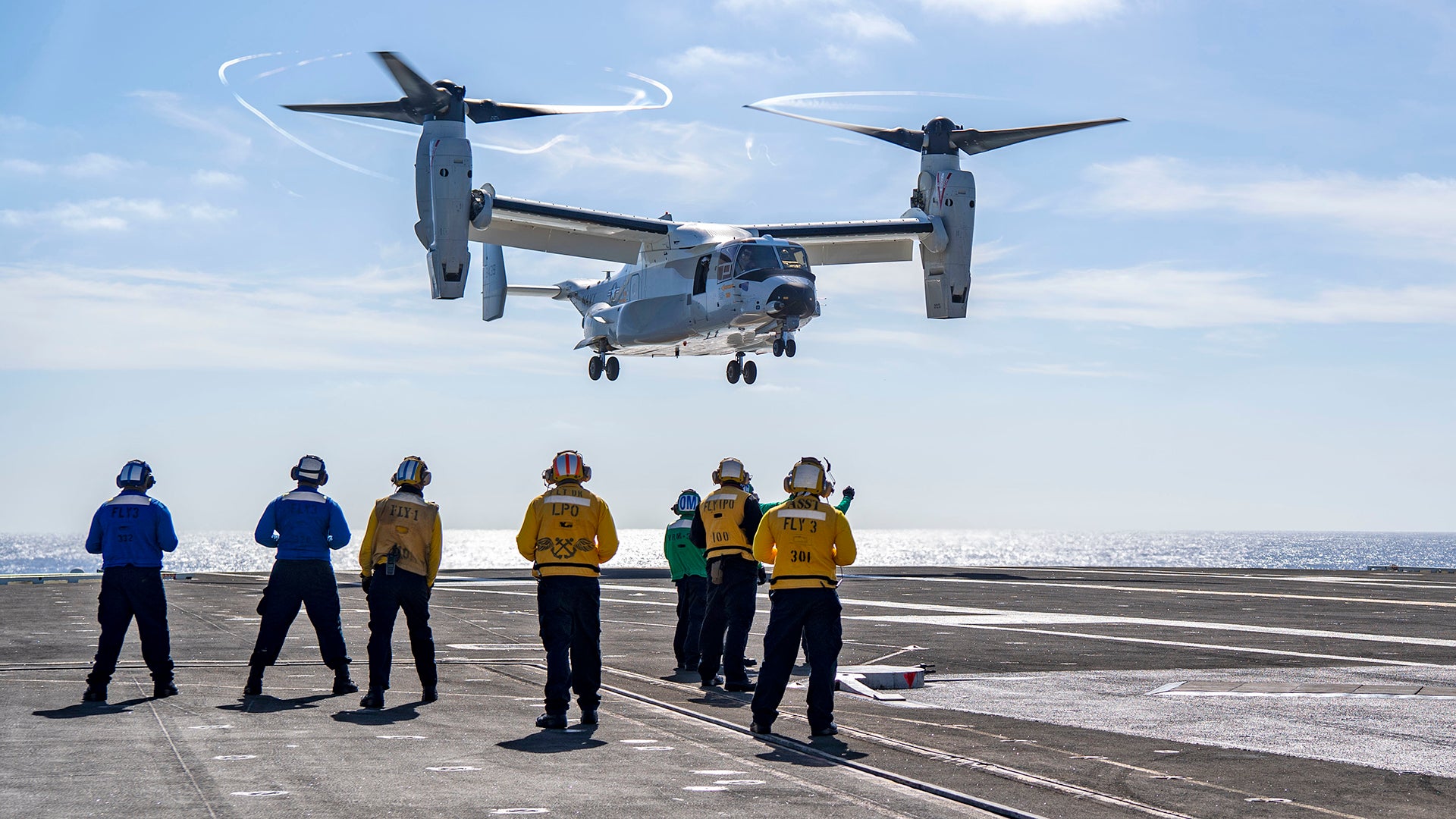The U.S. Navy’s new carrier onboard delivery platform, the CMV-22B Osprey tilt-rotor, has landed on an aircraft carrier for the first time. The landmark mission took place aboard the flight deck of the Nimitz-class nuclear aircraft carrier USS Carl Vinson underway in the Pacific Ocean, and photos have now been released.
The Vinson was conducting what the U.S. Navy described as “routine maritime operations,” when a CMV-22B assigned to Fleet Logistics Multi-Mission Squadron 30 (VRM-30), the “Titans,” paid a visit to the carrier on November 20, 2020.
The CMV-22B, which is an adaptation of the MV-22B used by the U.S. Marine Corps as its standard medium-lift assault support aircraft, is destined to replace the Navy’s existing C-2A Greyhound carrier onboard delivery (COD) aircraft, a design that first entered service in the mid-1960s.
Currently, C-2s play a vital role in providing COD to the Navy’s supercarriers, shuttling personnel, spare parts, mail, and other supplies to and from the ships and bases ashore.




The Navy signed a deal to buy 39 of the new tilt-rotors in June 2018. The CMV-22B purchase was part of a larger Osprey buy, worth a total of $4.2 billion to the Bell-Boeing joint venture that makes the aircraft, and also included 19 additional examples, a mixture of MV-22Bs for the U.S. Marine Corps and Japan and CV-22Bs for the U.S. Air Force.
The first CMV-22B unit, VRM-30 stood up at Naval Air Station North Island in California, on October 1, 2018. Meanwhile, training of the initial Navy CMV-22B crews is being carried out by the Naval Aviation Training Support Group (NATSG) at Marine Corps Air Station New River in North Carolina, overseen by Marine Medium Tiltrotor Training Squadron Two Zero Four (VMMT-204).
Eventually, the Navy plans to create a new wing-sized unit at North Island that will oversee both VRM-30 and the second operational CMV-22B squadron, VRM-40. Finally, VRM-50 will arrive at the base to serve as third a dedicated fleet replacement squadron, taking on the responsibility for training crews.



Prior to going aboard the Vinson, the Navy used the MV-22B to demonstrate the ability of the tilt-rotor to use rolling landings and takeoffs to touch down on an aircraft carrier’s deck and then get airborne again with large loads, including tests aboard the Nimitz-class aircraft carrier USS George H.W. Bush. This kind of ability is essential for the CMV-22B, which will be tasked to transport particularly bulky items, including spare F135 engines for the F-35C Joint Strike Fighter. However, the CMV-22B’s ability to move the F135 engine does come with some important caveats, as The War Zone discussed in this previous article.
There have been other concerns voiced about the CMV-22B’s suitability to the COD mission, too. These are discussed at length here, but they include lack of cabin pressurization, and the space required by the tilt-rotor to take off and land from a carrier, as well as maneuvering around the flight deck, and how this might affect the launching and recovering process.
While the MV-22B has stood in for the Navy’s COD variant of the tilt-rotor in the past, the CMV-22B configuration does incorporate some important differences for its role, including additional fuel capacity in the fuselage and wings to increase its overall range, extra communications equipment, a public address system in the main cabin, and special lighting to help with loading and unloading cargo at night.



The carrier trials of the CMV-22B come as the Navy seeks to declare initial operational capability for the type before the end of this year. The tilt-rotor COD fleet is expected to become fully operational four years after that, which would allow the last of the C-2s to be retired by 2026.
As well as replacing the fixed-wing C-2, it’s possible the CMV-22B could also change the way that the Navy moves cargoes around within the Carrier Strike Group. Under the current “hub and spoke” method, C-2s bring cargo or personnel to the carrier deck, before helicopters ferry them to individual vessels, where required. The tilt-rotor’s ability to carry underslung heavy loads could see them take on this role, too.
In recent weeks, the USS Carl Vinson has also hosted the Navy’s first operational F-35C squadron for flight-deck qualifications. Since F-35C operations require the Osprey’s ability to haul its F135 engine, it’s possible that the CMV-22Bs will accompany the fighter jet’s first operational cruise aboard the carrier, planned for 2021.



While there have been questions asked about the CMV-22B’s suitability for the COD role in the past, a rapid development path shows there’s little doubt that the US Navy is fully backing this variant of the Osprey as a replacement for the C-2. The first appearance of the new aircraft aboard a Navy aircraft carrier is the next milestone toward getting the CMV-22B into operational service. If everything goes as planned, the Navy’s Osprey will become a fixture of the carrier air wing, just like its fixed-wing predecessor.
Contact the author: thomas@thedrive.com
